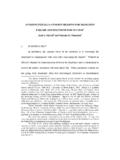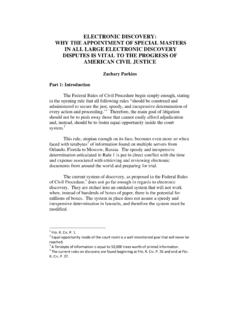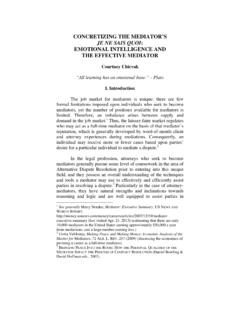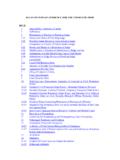Transcription of CONFLICT MANAGEMENT IN HOSPITAL SYSTEMS: NOT …
1 CONFLICT MANAGEMENT IN HOSPITAL SYSTEMS: NOT JUST FOR LEADERSHIP Dale C. Hetzler, Deanne R. Messina, Kimberly J. Smith I. Why? Experience tells us that the majority of errors in healthcare come from communication Our view is that these problems stem in large part from conflicts , what one writer has called the invisible CONFLICT that exists in Whether small or large, the important characteristic of conflicts for this discussion is that they exist, and they make it less likely that one healthcare person will communicate to another what may be important to the treatment outcome for the patient. Taking this thought one step further, if communication before an event occurs is critical to an outcome, then so is the communication that occurs after an event. It is this post-occurrence communication that dictates whether the institution has the ability to learn and improve from the experience, and also whether they have the ability to deal fairly and openly with the providers, patient and family involved.
2 Because good communication before and after care is the essence of good healthcare, it will be important for healthcare enterprises to anticipate that communication skills and CONFLICT skills will become primary predictors of the organization s ability to progress in both quality improvement and patient safety, and will therefore equip its caregivers and administrators with these skills. For those who do adopt this approach, they can expect lower turn-over, less burnout, increased patient loyalty and lower rates of medical 1 Joint Commission Resources: 2011 HOSPITAL Accreditation Standards. Oakbrook Terrace, Ill.: Joint Commission on Accreditation of Healthcare Organizations, 2011. 2 Matz, D.: The Inevitability and Perils of Invisible Health Care CONFLICT . Hamline J Pub L & Pol y 29(2):243-248. Summer 2005 3 Angermeier, et al: The Impact of Participative MANAGEMENT Perceptions on Customer Service, Medical Errors, Burnout, and Turnover Intentions.
3 J HC Mgmt 54(2) Mar/Apr 2009. The Joint Commission has issued a Leadership Standard that requires CONFLICT MANAGEMENT process to be available to administration, medical staff leadership and the governing Similar requirements have been added for physician leaders. Our discussion will not be addressing the need for CONFLICT MANAGEMENT process or policy for just leadership, but instead will propose how to install a CONFLICT MANAGEMENT -based approach for patients who have questions about the outcome of care and for employees and managers who are dealing with CONFLICT on the front lines in the environment of care. II. When Events Occur Existing Systems Create CONFLICT Healthcare is unique in many ways. At the same time it is similar to other enterprises in the ways in which people behave when something happens that could give rise to liability or professional discipline. The event could be an unintended outcome, the filing of a peer review grievance, the filing of a lawsuit or receipt of an alert from a Patient Safety Organization.
4 Many institutional processes and structures exist that describe the preferred communications pathways for dealing with these events. These structures each depend on people putting aside their personal fears and emotional filters and behaving professionally. These processes also exist independently of each other for the most part. Because each process has a different purpose and owner, this independence is intentional in many respects. Whether it is due to the structure necessary for applicability of a legally-recognized privilege that protects information from discovery (such as peer review) or the historical separation between quality functions and direct administrative processes, when an event occurs, several independent systems engage which compete for -- and often limit access to -- critical information necessary to reduce CONFLICT and to allow the organization to learn and improve.
5 When an event has occurred and the patient or family has questions about the outcome of care, the facility and each employee and provider should have the same moral and ethical 4 Joint Commission Resources: 2011 HOSPITAL Accreditation Standards. Oakbrook Terrace, Ill.: Joint Commission on Accreditation of Healthcare Organizations, 2011. commitment to the patient as when the patient initially asked for All should continue to act in the best interest of the patient. The long-term interests of the institution are also best served by the same professional and disciplined behaviors. But it is very difficult to teach and learn how best to behave when something has gone wrong. A. Event Response and Activities For the sake of discussion, we will be using as an example the unintended outcome of care. Treatment has been rendered, and in spite of the intentions and actions of all involved to create the ideal outcome for the patient from the medical encounter, the patient has not responded well to the treatment.
6 The outcome of treatment is unexpected. Not knowing what the cause of the outcome may be, the event is entered into the HOSPITAL s occurrence reporting system . The Event Dynamics Chart [Fig. 1] illustrates the majority of processes that exist in healthcare relating to the occurrence of situations that call into question the appropriateness of the outcome of care. It is just a partial list, as many other department processes cascade from those listed. Documentation In the left-hand quadrant of Fig. 1 are those items that pre-exist any known occurrence. These are the things that may lead up to the event, or be relevant to understanding the underlying environment of the outcome, such as the medical record, policies, documents, processes and people who may be involved in care or members of the patient family. Documents would include any policies relating to the methods used to treat the patient, as well as processes relating to delivery of care, communication among care givers, ordering and delivering pharmaceuticals, and diagnostic testing.
7 Documents would also include the ordinary business records created for billing and operations, and the elements of the patient medical record. 5 Scott, C.: Doctors as advocates, lawyers as healers. Hamline J Pub L & Pol y 29(1):331-399, Spring 2008. The items in this first quadrant all exist prior to the event. This quadrant also represents items which are typically discoverable should there be litigation relating to the Figure 1 Pre-event Event Analysis Event-related Response Event Resolution Policies Processes Medical Record Source Documents Witnesses Quality Review RC Analysis Peer Review Occurrence Report Disciplinary Process Education Process Improvement Administrative Public Relations Risk MANAGEMENT Licensing Board State Investigation Disclosure Ethics Committee Insurance Legal Claim Investigation State Report JCAHO Report ADR Risk MANAGEMENT Each healthcare facility has its own system and practices in place to deal with these events.
8 In many institutions, the first thing that follows recognition of an event is notice to risk MANAGEMENT . The risk MANAGEMENT office is connected to legal or quality, or sometimes other departments. In some jurisdictions the work of risk MANAGEMENT may be privileged. In others it may not be, so this arrow is above the line. If the risk MANAGEMENT department is part of a legal department, or acts at the instruction of legal services relating to events, it should be non-discoverable. The notice to risk MANAGEMENT of the occurrence of an event triggers the next several actions. If quality lives in the risk department, or if it is a separate department, quality is notified so its personnel can gather information that will assist the 6 Each jurisdiction will have differences in what may be discoverable. This is a placement of items based on a typical legal construction.
9 Organization in determining systemic causes and preventing future occurrences. The work being done by risk MANAGEMENT may be turned over to attorneys who will represent the organization should a claim arise from the event. The investigation that is performed by risk and legal is shared with the insurance adjusters and defense attorneys, and is used to evaluate the potential liability. This investigation is legally privileged and not discoverable. Administration Administration is notified of the event. This notice is part of ordinary business operations. This communication and all of the administrative communication and actions that follow are part of the evidence that can be used by either side in a trial. It is important to note that all of the e-mails that administration generates talking about events that have occurred are generally discoverable. The actual occurrence report that is filed by either a person on the floor or risk MANAGEMENT can be protected in some jurisdictions, depending on the way the reporting system is administered, and the extent of the peer review privilege in that jurisdiction.
10 It often becomes the data set that is used to track and trend this event within the quality and safety database of the organization. The specific report is usually maintained in a manner that preserves its confidentiality and privilege. Administration will typically include public relations in its list of offices that are notified of an event that is significant. This is an important business consideration, and remember that all of the information and documents that go to a public relations office will be discoverable in litigation. By this time, risk MANAGEMENT will have opened a potential compensable event or PCE file if the event is significant, and will put insurance carriers on notice if that is the method it has for financing potential HOSPITAL liability. The efforts of risk MANAGEMENT to gather information in anticipation of litigation, if properly performed, and if the risk MANAGEMENT office is within legal services, should be protected from discovery in most jurisdictions under the attorney-client privilege.









